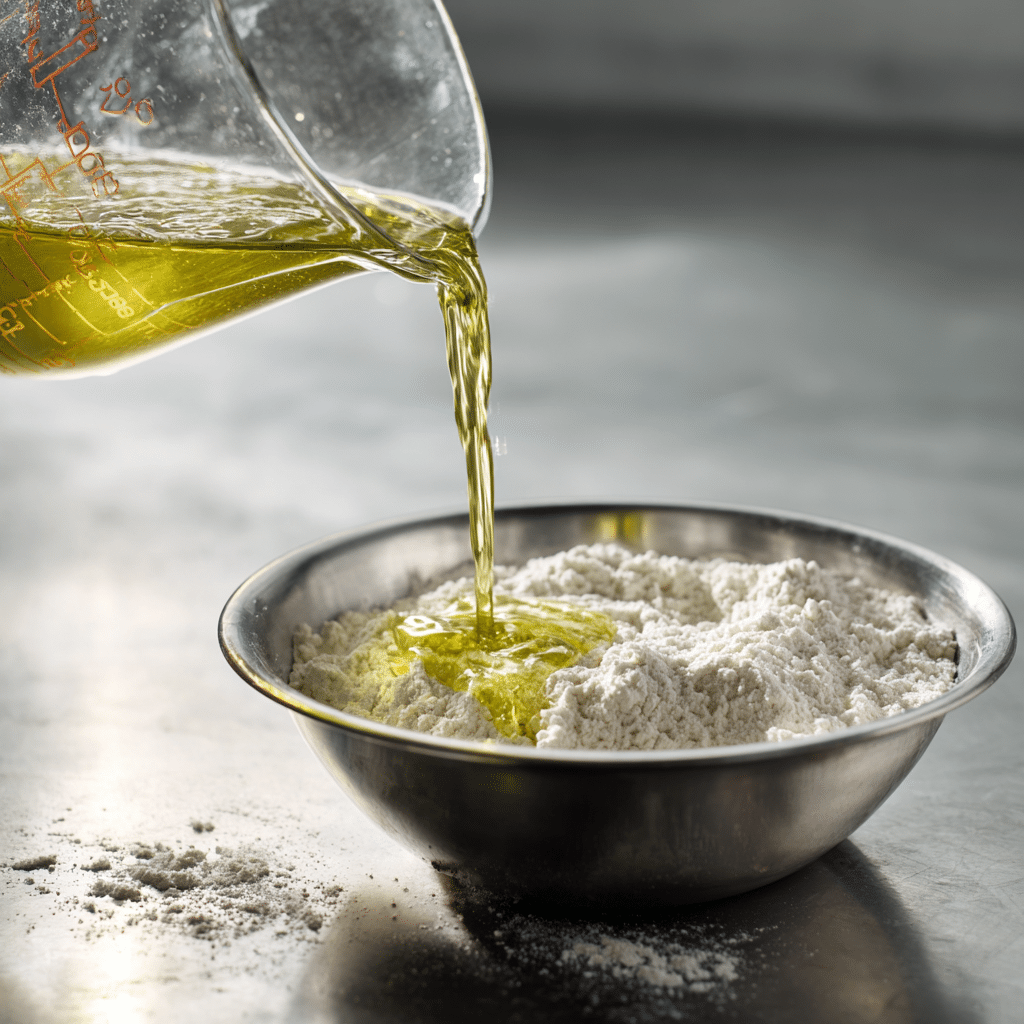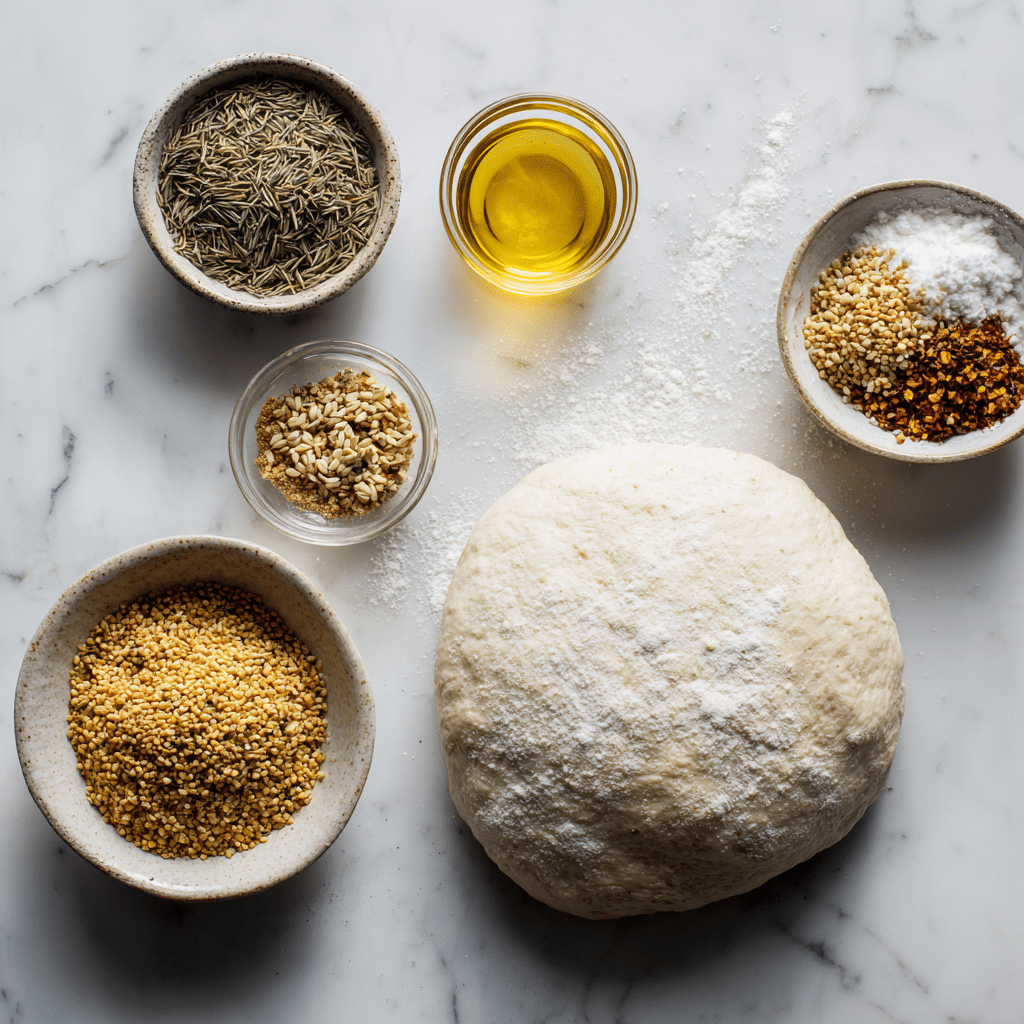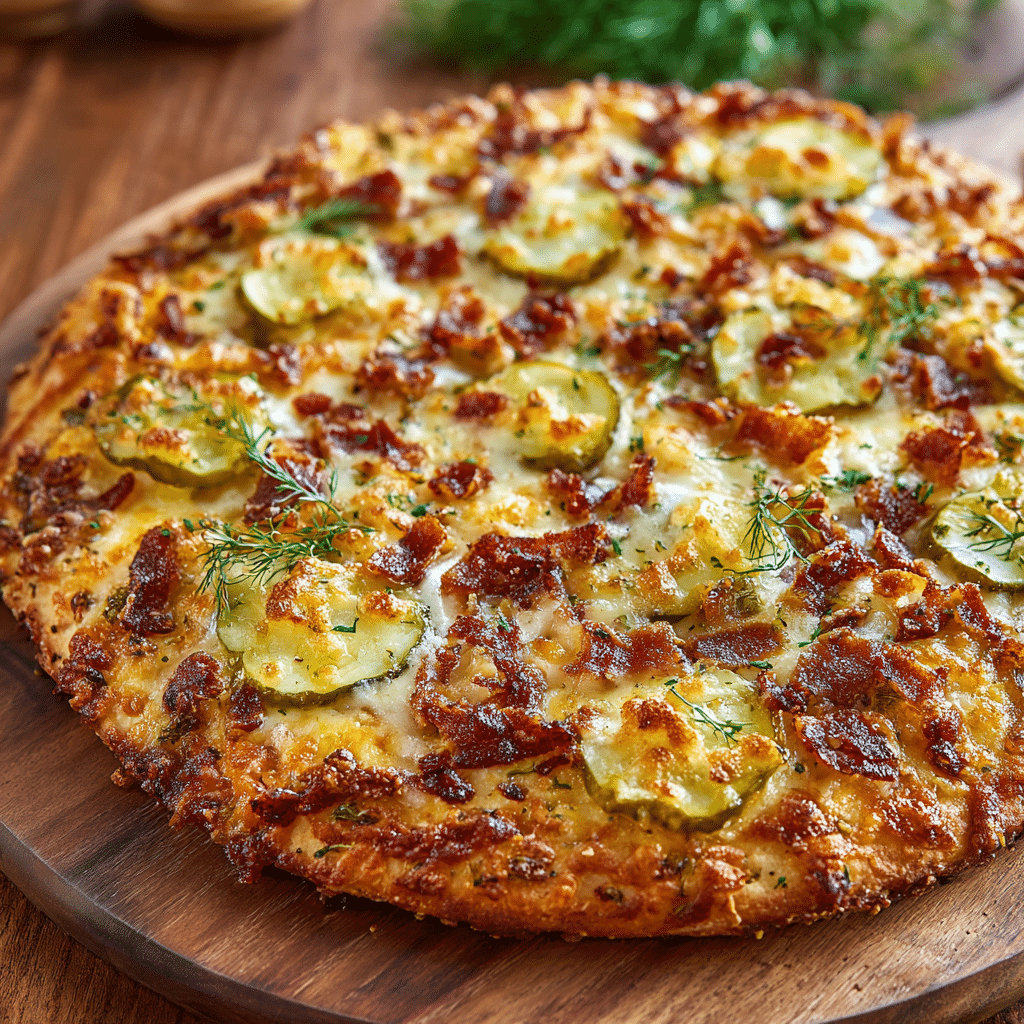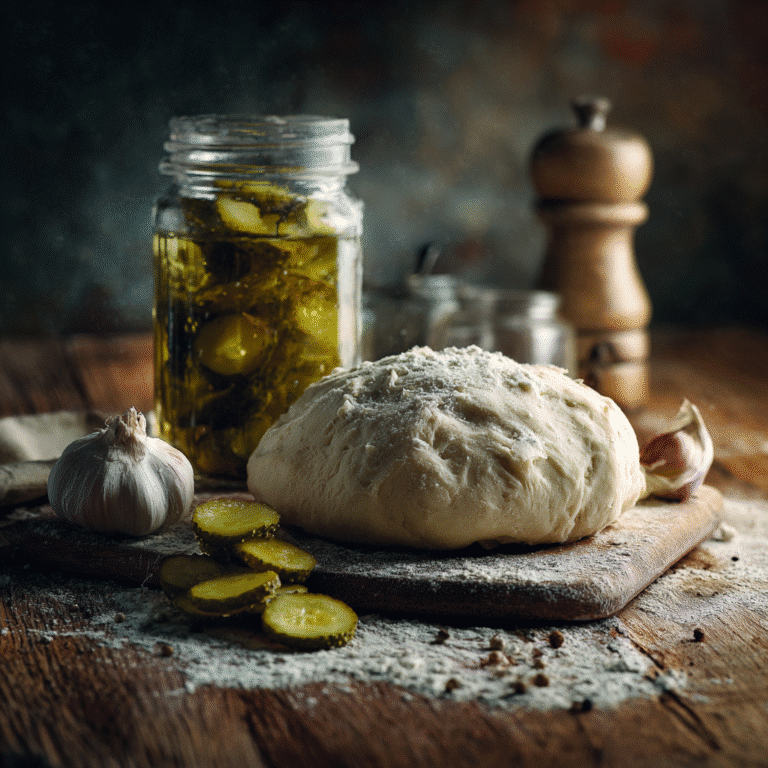Ever thought of adding pickle juice to pizza dough? Sounds wild, right? But here’s the deal it’s not just a weird internet trend. It’s a delicious, zesty twist on traditional pizza crust that hits all the right notes: tangy, salty, garlicky, and totally addictive. Whether you’re a diehard pickle fan or just craving something offbeat, pickle pizza dough might become your new go-to.
Thank you for reading this post, don't forget to subscribe!In this guide, we’ll cover everything from how pickle juice affects your dough’s rise to how much dill you really need to make the crust sing. Plus, we’ll answer some surprising FAQs and give you creative ideas that go beyond just plopping pickles on a pizza. Ready to roll out something deliciously different? Let’s go.
Table of Contents
What is Pickle Pizza Dough?
The Rise of Pickle-Flavored Everything
From chips to vodka, pickles have gone from deli sides to full-blown flavor trend. But it was the rise of pickle pizza especially with viral white-sauce versions topped with sliced dills that really shook things up. Food trucks, social media chefs, and even major pizza chains started tossing out traditional rules and embracing brine.
Now, we’re taking it one step further: baking that pickle flavor right into the dough.
It’s not just about novelty it’s about depth. That vinegar-salty snap from pickle juice or crushed dill seeds adds a punch of flavor regular water just can’t match. And let’s be honest: if you’re already piling pickles on your pizza, why stop at the crust?
What Makes Pickle Pizza Dough Unique
The magic of pickle pizza dough lies in two things:
- The liquid base Instead of just water, you use pickle brine (or a mix of brine and water) to give your dough a sour kick.
- Flavor-infused flour Some recipes toss in dried dill, garlic powder, or even mustard seeds right into the flour for an herbaceous hit.
This isn’t a subtle change. You’re going to taste it and that’s the point. Done right, the crust has a chewy, golden texture with a zing that complements creamy sauces and fatty toppings like cheese or bacon.
A few unique traits of pickle pizza dough:
| Trait | What Makes It Stand Out |
|---|---|
| Flavor | Tangy, briny, salty, with herbal notes |
| Texture | Chewy, slightly crisp, golden crust |
| Aroma | Savory, with hints of garlic and dill |
| Color | Slightly golden-green (from brine) |
And while it might sound intense, the flavor mellows as it bakes, leaving you with a balanced, craveable crust that’s anything but boring.
Print
Pickle Pizza Dough from Scratch: What You Need
- Total Time: 1 hour 45 minutes
- Yield: 1 large pizza crust
Description
A zesty, tangy twist on classic pizza dough—this pickle pizza crust is briny, garlicky, and downright addictive. Perfect for adventurous eaters and pickle lovers alike.
Ingredients
- 3 cups all-purpose or bread flour
- ½ cup pickle juice
- ½ cup warm water
- 1 packet (2¼ tsp) active dry yeast
- 1 tsp sugar
- 1 tsp salt (adjust if brine is very salty)
- 1–2 tsp dried dill
- 1 tsp garlic powder
- ½ tsp onion powder
- 1 tbsp olive oil (plus more for brushing)
Instructions
- In a bowl, mix warm water and pickle juice with sugar and yeast. Let sit for 5–10 minutes until frothy.
- In a large mixing bowl, combine flour, salt, dill, garlic powder, and onion powder.
- Pour in the yeast mixture and olive oil. Mix until a dough forms.
- Knead the dough on a floured surface for 8–10 minutes until smooth and elastic.
- Place in a lightly oiled bowl, cover, and let rise 1–2 hours or until doubled in size.
- Punch down the dough, shape into a ball, and let rest 10 minutes before rolling out.
- Preheat oven to 475°F. If using a stone or steel, preheat it as well.
- Roll dough into desired shape, pre-bake for 5–6 minutes for a crispier crust.
- Add toppings and bake until golden and bubbly.
- Optional: Brush edges with a mix of olive oil and pickle juice for extra zing.
Notes
For bold pickle flavor, use 100% brine as liquid. Reduce added salt accordingly and allow extra rise time. Pair with creamy sauces and salty toppings like cheese or bacon.
- Prep Time: 20 minutes
- Cook Time: 15 minutes
- Category: Pizza Dough
- Method: Baked
- Cuisine: Fusion
Can You Add Pickle Juice to Pizza Dough?
Pickle Juice as a Liquid Substitute
Here’s the short answer: Yes, you absolutely can use pickle juice in pizza dough and it’s actually delicious.
In most pizza dough recipes, water makes up about 55–65% of the flour weight. To infuse your dough with briny flavor, you can substitute part or all of that water with pickle juice. But the key here is balance.
Recommended ratio:
- Use ½ cup pickle juice + ½ cup warm water for every 3 cups of flour.
- Or go bold with 100% brine, but only if you’re using a milder, less acidic variety.
Why this works:
Pickle juice isn’t just salty vinegar it’s got garlic, dill, and spices. Swapping it in adds deph and brightness, giving your crust a built-in zing that plays beautifully with creamy cheeses and crunchy toppings.
But there’s a twist…
Does Pickle Juice Affect Dough Rise?
It can especially if you don’t know what you’re working with.
Here’s what’s going on:
- Acidity slows down yeast. Most brines have a pH of 3 to 4, which is quite acidic compared to water (which is neutral at 7). That acid can inhibit yeast activity, causing a slower or weaker rise.
- Salt content can be high. Pickle juice often contains more salt than typical dough recipes call for, and excess salt can also interfere with yeast growth.
The fix? Just adjust:
| Factor | What to Do |
|---|---|
| Acidic brine | Use half brine, half water to keep yeast happy |
| Salty brine | Cut added salt in recipe by ¼ to ½ tsp per cup of brine |
| Rise time | Let it rise longer (cold fermentation works great) |
| Yeast amount | Use a tiny bit more yeast if using 100% brine |
Pro tip: Use active dry yeast instead of instant if you’re using full-strength brine it’s more robust in acidic environments.
So yes, pickle juice can affect rise, but it’s easy to work around. And the payoff? A uniquely flavorful, tangy crust that makes people do a double-take.
Looking for more crust inspiration? Check out this high-fiber sourdough variation.

Choosing the Best Dough for Pickle Pizza
Homemade vs Store-Bought Dough
Let’s be honest we’ve all had nights where grabbing pre-made dough is a lifesaver. And yes, you can absolutely use store-bought dough for pickle pizza. But there’s a catch: you won’t get that deep, layered flavor unless you modify it.
Here’s how they stack up:
| Dough Type | Pros | Cons |
|---|---|---|
| Homemade Dough | Total control over salt, hydration, flavor | Slightly more prep time |
| Store-Bought | Convenient, consistent | Bland, unless you add dill, garlic, or brine flavoring |
If using store-bought:
- Brush with a mix of pickle juice + olive oil
- Sprinkle with dried dill, garlic powder, or onion salt
- Let it sit at room temp for 30 mins to relax before shaping
This mini-hack builds in pickle flavor without having to remake the dough from scratch.
But if you’ve got a little time on your hands? Go homemade. Especially when you want that soft interior with a crisp bite and zesty tang woven into every crumb.
Ideal Crust Styles for Pickle Pizzas
Different crust styles handle toppings and moisture differently. When it comes to pickle pizza, your best bet is a crust that:
- Can stand up to moisture from pickles and sauces
- Has enough structure to crisp without turning soggy
- Offers enough chew to carry bold flavors
Here are some solid options:
| Crust Style | Why It Works for Pickle Pizza |
|---|---|
| New York-style | Thin yet strong, good base for briny toppings |
| Neapolitan-style | Airy, fast-baking, but benefits from pre-baking crust |
| Detroit-style | Thick, pan-baked, ideal for edge-to-edge cheese + brine |
| Flatbread | Crunchy and quick great for pickle pizza “bites” |
Avoid doughs that are overly soft, wet, or enriched with too much oil or dairy they tend to go mushy when paired with juicy toppings like sliced pickles.
Chef Clara’s tip: A 24-hour cold ferment in the fridge develops flavor and gives the dough enough bounce to handle briny toppings like a champ.
How to Keep Your Pickle Pizza Dough from Getting Soggy
The #1 Mistake: Wet Toppings on Wet Dough
This is where most pickle pizzas go wrong. The crust turns pale and soggy, not crisp and golden. Why? Moisture overload.
Pickles are packed in brine, which means they release water as they bake especially when layered onto soft dough. Combine that with creamy sauces, and you’ve got a puddle on your hands.
Here’s how to prevent soggy crust:
- Drain your pickles well. Pat them dry with a paper towel before using.
- Slice thin. Thick pickle slices = more moisture and uneven heating.
- Pre-bake your crust. Even 5–6 minutes in a 475°F oven gives it a head start and forms a dry barrier.
For thin-crust styles, a pizza stone or steel helps the bottom crisp up fast. For thick pan styles like Detroit crust, try brushing the base of the dough with olive oil mixed with a splash of pickle juice before baking.
“Pickle pizza dough shines when it’s crisp, golden, and strong enough to carry flavor-packed toppings so give it the support it needs.”
Smart Dough Techniques for a Crispier Base
If you’re making your pickle pizza dough from scratch, a few strategic choices can make all the difference:
| Tip | What It Does |
|---|---|
| Use bread flour | Higher protein = chewier, stronger structure |
| Add a tablespoon of cornmeal | Gives extra crunch on the bottom when baking |
| Preheat your pan or stone | Immediate heat shock seals the crust faster |
| Roll thinner | Less moisture trapped inside the dough |
Also, consider using a garlic-dill infused olive oil as your “sauce” base instead of traditional tomato or cream sauces. It amps up flavor while minimizing liquid content.
Seasoning and Flavor Add-Ins for Pickle Pizza Dough
How Much Dill or Garlic to Add to Dough?
Let’s be real: nobody wants to bite into dough that tastes like a jar of straight dill. But used right? It turns your pickle pizza dough into a flavor bomb.
So how much is just right?
- Dried dill weed: 1 to 2 teaspoons per 3 cups of flour
- Granulated garlic or garlic powder: 1 to 1½ teaspoons
- Onion powder: ½ to 1 teaspoon for depth
- Mustard seeds (optional): ½ teaspoon crushed or whole

Those small amounts might not seem like much, but once they bloom in the warm dough, the flavor amplifies fast especially when paired with brine.
Pro tip: Add these seasonings directly to your flour before mixing, so they’re evenly distributed.
| Add-In | Flavor Boost | Best Used In |
|---|---|---|
| Dill weed | Classic tangy herb | All pickle pizza doughs |
| Garlic powder | Earthy, savory edge | Thin and crispy styles |
| Mustard seed | Warm bite + texture | Pan and deep-dish crusts |
| Onion powder | Subtle sweetness | Balances acidic brine base |
Complementary Spices: What Works with Pickles
Dill’s the hero, but it’s not the only one that plays well with pickles. You can layer in other subtle flavors to round out the crust without overpowering your toppings.
Try:
- Celery seed (¼ tsp): Adds a deli-style twist
- Crushed red pepper: For heat, especially with creamy sauces
- Black pepper (fresh cracked): Adds brightness and bite
- Smoked paprika: Warmth that balances the brine
Keep your total add-ins under 1.5 tablespoons per 3 cups of flour, or your dough may not rise or stretch properly.
And don’t forget your toppings matter too. If they’re bold (like ranch, hot sauce, or bacon), dial your dough seasoning down a notch so everything works together.
Love bold pickle flavor? Don’t miss our pickle sandwich creation layered with crunch and tang.
Creative Topping Ideas for Pickle Pizza
The Classic Dill Pickle + White Sauce Combo
This one’s the gold standard. It’s creamy, salty, tangy—and just plain addictive.
Here’s how to build it:
- Base sauce: Garlic white sauce or ranch spread thin over your pickle pizza dough
- Cheese: Mozzarella + provolone (or Monterey Jack for extra melt)
- Pickles: Thin-sliced dill rounds, well-drained and patted dry
- Extras (optional): Crumbled bacon, red onion, or a light drizzle of hot sauce
Bake it on a pizza stone or steel at 475°F until bubbly and golden. The crispy edges of the crust, paired with that pickle punch, are totally next-level.
Want to take it up a notch? Sprinkle the hot pizza with fresh chopped dill or a few drops of pickle juice just before serving.
This combo turns doubters into believers. Fast.
Unusual Add-Ons That Actually Work
If you’re the adventurous type (and let’s face it, you’re making pickle pizza dough), here are some bold pairings that weirdly work:
| Topping Combo | Why It Works with Pickle Dough |
|---|---|
| Buffalo chicken + pickles | Tangy heat + cool brine = crave-worthy contrast |
| Spicy mayo drizzle | Adds creamy heat over that zesty crust |
| Fried jalapeños | Crunch + spice, balances the dough’s acidity |
| Pulled pork + mustard BBQ | Southern-style vibe that marries brine + sweet |
| Hot Cheetos or crushed chips | Adds texture and unexpected crunch |
| Sliced tomatoes + feta | A fresher, Mediterranean take with salt snap |

Whatever direction you go, just remember the golden rule: balance bold toppings with restraint in the crust. Let your pickle pizza dough do its thing without overwhelming it.
Frequently Asked Questions About Pickle Pizza Dough
Can you add pickle juice to pizza dough?
Yes, you can—and it’s one of the easiest ways to infuse your dough with bold, briny flavor. Just replace part or all of the water in your dough recipe with pickle juice. A good starting ratio is 50/50 brine to water. Be mindful of the salt and acidity levels, as these can slightly affect yeast activity and rise time.
What kind of dough is best for pickle pizza?
The best dough for pickle pizza is one that’s strong enough to hold moisture and bold toppings without going soggy. We recommend a high-protein dough made with bread flour, or a classic New York-style crust. For deep-dish or pan styles, use olive oil in the pan for crisp, golden edges that contrast beautifully with the tangy pickle flavor.
How do you prevent soggy crust when making pickle pizza?
Start by drying your pickles well—moisture is the enemy of a crisp base. Then, pre-bake your pickle pizza dough for 5–6 minutes before adding sauce or toppings. You can also sprinkle cornmeal on your pan or stone for extra crunch and use a garlic-oil base instead of watery sauces.
Does pickle juice affect the rise of pizza dough?
It can. Pickle juice is acidic and salty, both of which slow down yeast activity. If you’re using full-strength brine, expect a longer rise—or use a little extra yeast. Most bakers get great results by using half pickle juice and half water to maintain flavor without stalling the fermentation.
Can you use store-bought dough for pickle pizza?
Absolutely. If you’re short on time, store-bought pizza dough can be a great option. To add that classic pickle flavor, brush the dough with a mix of pickle juice and olive oil, and sprinkle on garlic powder or dried dill before topping and baking.
Don’t miss our quick guide to dressing up store-bought dough like a pro.
How much dill or seasoning should you add to pickle pizza dough?
For a flavorful but balanced dough, use:
1 to 2 teaspoons dried dill
1 teaspoon garlic powder
½ teaspoon onion powder
These amounts are ideal for about 3 cups of flour. Too much seasoning can overpower the crust, so if you’re loading your pizza with bold toppings, go lighter on the spices.
Conclusion: Why Pickle Pizza Dough Deserves a Spot in Your Recipe Rotation
If you’re tired of the same old crust, pickle pizza dough is the game-changer you didn’t know you needed. It’s briny, bold, and surprisingly versatile especially when paired with creamy sauces, crisp toppings, and a hint of fresh dill.
Whether you’re team homemade or store-bought, brine in the mix adds character and complexity that standard dough just can’t match. From garlic-dill seasoning to white sauce bacon bombs, there’s no end to the flavor combos waiting to happen.
So the next time you’re craving something quirky, skip the ordinary and roll out a dough that brings some tang to the table.
For more creative dough ideas, see our sourdough discard English muffins.
Follow us on Facebook for fresh new recipes, cooking tips, and food inspiration every week!
Let’s face it pickle pizza dough might sound weird, but once you try it, you’ll wonder why it took you so long.

